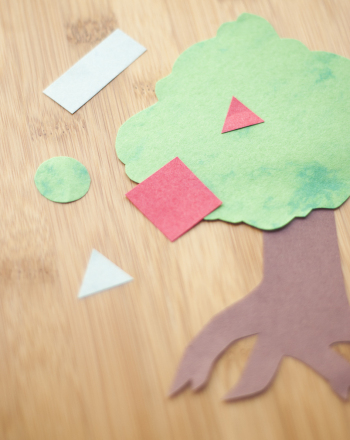 Want to test your child’s shape recognition skills? Challenge her to a game of shape match-up—an entertaining way to boost her observational ability. With this matching game, the fun abounds as the learning and creativity flourish! She’ll craft the “game board” out of construction paper, inadvertently boosting her fine motor skills as she cuts the pieces!
Want to test your child’s shape recognition skills? Challenge her to a game of shape match-up—an entertaining way to boost her observational ability. With this matching game, the fun abounds as the learning and creativity flourish! She’ll craft the “game board” out of construction paper, inadvertently boosting her fine motor skills as she cuts the pieces!
What You Need:
- Construction paper
- Scissors
- Paste or glue
What You Do:
- Start out by helping your child craft a big tree that will constitute the playing board. Cut the leaves and tree top from a piece of green construction paper. Invite her to make the edges rounded if she wishes.
- Next, talk a bit about the tree. Does she want it to be tall or short? Should it have a thin trunk or a thick one? Talking about the tree is a great excuse to practice descriptive words, especially ones having to do with size– these are key math concepts for preschoolers. Once you’ve decided on a trunk shape, let her cut it out from the brown construction paper.
- Paste the green tree top onto the top of the brown tree trunk.
- After your child has fully constructed the tree, ask her to leave the room. Cut a bunch of colored pairs of shapes, such as triangles, squares, circles, ovals, and more out of construction paper. Vary the colors and shapes so that the pairs are not exact matches. For example, make a red circle and a green circle, and so on.
- With at least five to ten sets of shapes cut out, it’s time to glue one of each set to the tree. Try to space them out nicely, gluing a few on the trunk if you run out of space. Perhaps those shapes are falling off the tree! Once there is one from each set glued onto the tree, place the rest of the shapes on the table.
- Invite your child back into the room, and then encourage her to see how fast she can match up the shapes to their partners. Guide her with hints like “warmer” and “cooler”—based on her distance from the correct spot. Make sure to congratulate her on each pairing!
The more shapes involved, the more difficult this game becomes. For a more advanced twist, try making smaller and larger shapes, and then matching smaller triangles to larger triangles, and so on.
This guest post was sent to us by Education.com, an award winning educational materials like worksheets, games, lesson plans and activities designed to help kids succeed.


Leave a Reply